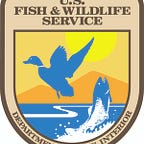Making an Impact: The Fish and Wildlife Service Leads by Example to Reduce Bird Collisions
By Lev Levy, public affairs officer, Pacific Region of the U.S. Fish and Wildlife Service
Robins and cedar waxwings love hawthorn berries.
The glossy, scarlet berries emerge in the fall and hang out through the winter, providing nutrition to songbirds after the summer berry season has passed. When the berries pop out, songbirds flock to the hawthorn trees outside of the 911 Federal Building in Portland, Oregon. Now, after years of work, the windows next to those berry-rich trees are safer for all birds, thanks to installed decals that help prevent bird collisions.
Since 2018, the hawthorn trees have become even more of a berry oasis. David Leonard, a recovery biologist with Ecological Services, worked with other employees on the building’s green team to help install bird-friendly decals on its ground-level windows. These decals — barely visible vertical lines that run from a window’s top to bottom — are a critical aspect of the U.S. Fish and Wildlife Service’s efforts to prevent bird collisions.
“Those trees just get loaded with berries,” Leonard said. “We noticed that there were birds — songbirds and migratory birds — that were crashing into the windows. Some died and others were able to fly away. It was important for us to get something done.”
Scientists recently found out that North America has lost almost three billion birds during the last 50 years, or nearly one in four of its birds. Birds in every ecosystem have been lost to changing climates, predators, an increase in invasive species, and land use practices. Bird collisions with windows account for up to a billion bird deaths per year in the U.S. alone, and birds that migrate at night in the spring and fall are particularly vulnerable.
Reducing bird collisions is a part of the Service’s partnership on the Three Billion Birds initiative, an effort to conserve and restore healthy bird populations across the hemisphere. While tall glass skyscrapers are responsible for some of these bird fatalities, most bird collisions occur less than twenty feet from ground level, including at homes and on low-rise buildings.
Leonard and Mike Green, the deputy chief of Migratory Birds, worked for years to build momentum to put decals on the 911 Federal Building’s glass. Jim Silk, the General Service Administration’s building manager, enthusiastically joined in the effort after learning about how bird-friendly decals could help prevent collisions. In about 2018, the Service installed the decals on the building’s glass.
Other Service buildings are jumping into the bird-safe building effort. For example, the new Ankeny Hill Nature Center at Ankeny National Wildlife Refuge was built with bird-friendly glass features. The features not only prevent bird collisions, but also provide an educational opportunity for Refuge visitors.
The Service has taken steps to make all agency buildings safer for birds, including modifying policies to require new builds and major renovations to be built with bird-friendly design. Nationwide, the Service is surveying buildings to assess which are the highest risk for bird collisions. From there, the Service will prioritize retrofits for where it’s most needed.
“The overarching goal is to reduce bird collisions and protect migratory birds,” Migratory Birds Permit Specialist Jennifer Urmston said. “We’re starting here with the Service and trying to practice what we preach. If we’re going to create change, then we need to focus on our own buildings first.”
Homeowners can assess the risk of bird collisions on their own homes with user-friendly apps. There are also Seven Simple Actions that everyone can take, including turning out lights at night, building catios, and buying bird-friendly coffee. We can all make an impact — and prevent collisions — and join in a journey to restoring the three billion birds that have been lost in less than a lifetime.
